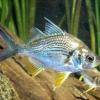Sepik glass perchlet - Parambassis confinis
Scientific name: Parambassis confinis
Common name: Sepik glass perchlet
Family: Ambassidae
Usual size in fish tanks: 8 - 10 cm (3.15 - 3.94 inch)
014
Recommended pH range: 7.5 - 8.5
Recommended water hardness: 2 - 12°N (35.71 - 214.29ppm)
0°C 32°F30°C 86°F
Recommended temperature range: 22 - 28 °C (71.6 - 82.4°F)
The way how these fish reproduce: Spawning
Where the species comes from: Oceania
Temperament to its own species: peaceful
Temperament toward other fish species: peaceful
Usual place in the tank: Middle levels
Origin
The Sepik glass perchlet are to be found in Oceania and New guinea where they occupy floodplains and small local streams. It is believed that some of their close cousins may even inhabit brackish waters.
Short description
The Sepik glass perchlet belongs to the family of Ambassidae of which there are believed to be approximately 50 members. This family covers the Asiatic glassfish which vary greatly in size but are usually found in the same habitats. This specimen reaches an adult size that averages to about of just below 4 inches making them one of the smaller members of this family as some of the species can reach a size of up to 10 inches. They are classed as a peaceful species and in the aquarium they will occupy the middle levels of the water column, they should be housed with tank mates of a similar size as they can be seen as a food source with larger species.
Lifespan
If cared for correctly the Sepik glass perchlet will have an average lifespan of 3-5 years though some specimens have been recorded as living for up to 8 years.
General care
Not a difficult fish to care for as they are classed as a hardy species but like all species they should be given high water quality in the aquarium. The minimum sized aquarium that should be used used will need to be at least 3 feet (90cm) in length and 1 foot (30cm) wide. They prefer to be kept in small groups and this will make them feel more secure in the aquarium. The aquarium should be fully cycled and always use a filtration system that is rated for the total water volume. As they occupy the middle levels, the choice of substrate is a personal choice but they do prefer planted aquariums so smooth edged gravel may be the best option. Hiding places can be added with the use of rock or wood but this is also a personal choice by the keeper.
The water temperature should be set between 22-28°C (72-83°F) and range the pH between 7.5-8.5. To keep the water quality high regular water changes should be performed of at least 10% weekly and keep the water well oxygenated with careful position of the filter outlet to increase gaseous exchange.
Feeding
When first added to the aquarium the Sepik glass perchlet may be slow to feed but once they settle after a couple of days they should accept all foods offered. In the wild these fish feed on small crustaceans and insects, they only have small mouths so the food offered should reflect this. Use a quality flake or small pellets for the staple diet but they will require treats of meaty foods. These can be offered in the form of live or frozen foods such as brine shrimp, bloodworms or artemia.
Sexing
Difficult to sex but it is believed that mature males develop a deeper body shape compared to mature females.
Breeding
These are not the easiest species of fish to breed but it is best to set up a separate breeding tank with the same water parameters as the main aquarium. Add some plants and you will need to use a small group of parent fish to guarantee a pair. They are egg scatterers and once deposited the parent fish should be removed to prevent the eggs from being eaten. The fry should hatch after 24 hours and once free swimming can be fed on infusoria or newly hatched brine shrimp. Only feed small quantities with each meal and carefully syphon out some water each day and replace with clean water to keep the quality high.

 Sailfin
Sailfin  Giant
Giant  Indian
Indian